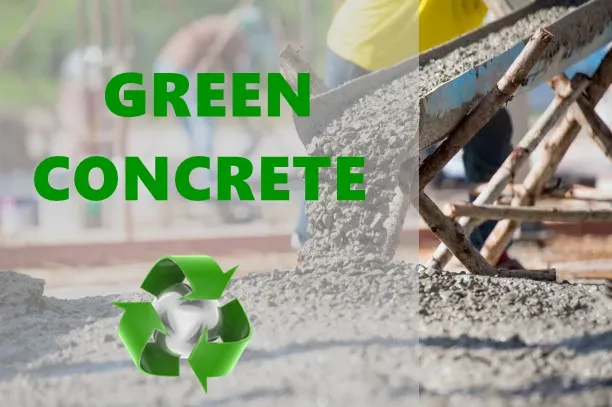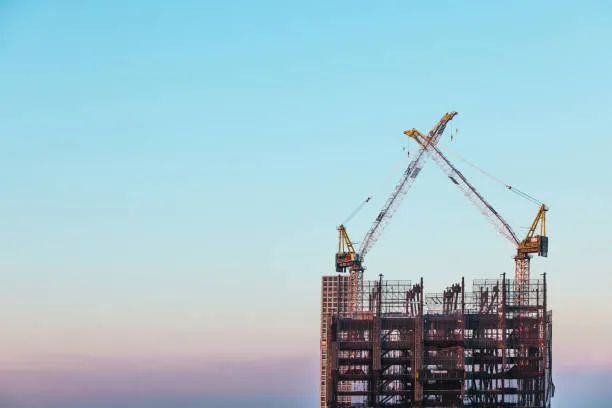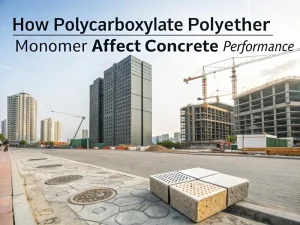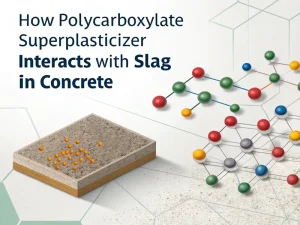Blog

In the current global consensus on environmental protection and sustainable development, green concrete is an inevitable product of advances in materials science and technology and socially sustainable development. It is an advanced civil engineering material with environmental coordination and adaptive characteristics.
Green concrete can be divided into green high-performance concrete, recycled aggregate concrete, and environmentally friendly concrete. Strengthening the research and development of supporting technologies for green high-performance concrete, making it ideal and suitable for various application scenarios, expanding its application scope, and increasing the promotion of green concepts have always been our goals.
HPEG 2400, as polycarboxylate ether raw materials in the field of concrete, is injecting new vitality into the development of green concrete with its excellent environmental performance, promoting the entire construction industry towards a more environmentally friendly and sustainable direction.
In the entire production and application process of green concrete, HPEG 2400 greatly reduces potential threats to the health of operators due to its low toxicity. Compared to the common harmful heavy metals and highly volatile organic compounds (VOCs) in traditional chemical additives, the pure formula of HPEG 2400 effectively reduces the risk of occupational diseases caused by inhaling harmful substances in workplaces such as concrete mixing plants.
When operators come into contact with additives containing HPEG 2400, there is no need to overly worry about the damage to the respiratory system, skin, and nervous system, thus creating a safe and healthy working environment for the production of green concrete.
From a macro perspective of the ecological environment, HPEG 2400 demonstrates excellent environmental friendliness. Even in extreme situations such as accidental leaks or emissions, its stable chemical structure ensures that it will not decompose into toxic and harmful substances in the natural environment, thereby minimizing the risk of pollution to soil, water bodies, and the atmosphere.
This feature enables green concrete containing HPEG 2400 to coexist harmoniously with the surrounding ecological environment throughout its entire lifecycle, from production, and use to disposal, effectively fulfilling the solemn commitment of green buildings to environmental protection.
HPEG 2400 plays a crucial optimization role in the formulation design of green concrete. Its unique performance enables concrete to significantly reduce the amount of key raw materials such as cement and aggregates while achieving the same engineering performance standards.
Taking high-rise building construction as an example, using high-performance green concrete containing HPEG 2400 can reduce cement usage by 10% -15%. This not only effectively alleviates the enormous pressure on natural resources such as limestone in the cement production process, but also significantly reduces the release of carbon dioxide due to cement production, laying a solid foundation for building resource-saving green buildings.
The precise control of concrete workability by HPEG 2400 directly leads to a significant reduction in energy consumption.
During the concrete mixing stage, good workability ensures that the materials can be quickly and evenly mixed, greatly reducing the mixing time and lowering the energy consumption of the mixing equipment. In the transportation process, high-fluidity green concrete performs well, effectively avoiding pipeline blockage and significantly reducing pumping pressure, thereby reducing energy consumption during transportation.
In addition, HPEG 2400 improves the durability of concrete, reduces the frequency of maintenance and repair during the use of buildings, further saves a large amount of energy and resources for maintenance work, and enables efficient energy utilization of green concrete throughout its entire lifecycle.

In the grand blueprint of the United Nations Sustainable Development Goals (SDGs), the application of HPEG 2400 in green concrete has become an important support for achieving the goal of “sustainable cities and communities”.
By improving the durability and environmental performance of concrete, it helps to create stronger, more durable, and environmentally friendly building structures, significantly enhancing the sustainability of urban infrastructure.
Whether it is urban high-rise buildings or infrastructure construction, the use of green concrete containing HPEG 2400 can effectively extend the service life of buildings, reduce resource waste and environmental pressure caused by urban renewal, and create more livable and environmentally friendly living spaces for urban residents.
Under the key goal of ‘climate action’, HPEG 2400 has become an active participant in addressing global climate change by optimizing the consumption of green concrete raw materials and energy utilization.
Its dual effect of reducing cement consumption and energy consumption directly lowers carbon emissions in the concrete production process. Meanwhile, due to the improved durability of green concrete structures, the additional carbon emissions caused by building damage and reconstruction have been reduced, contributing a solid force to mitigating global climate change.
Life cycle assessment (LCA), as a comprehensive method for assessing the environmental impact of products or systems, covers the entire lifecycle of green concrete, from raw material extraction, cement production, concrete mixing, transportation, construction, and use to final demolition.
By quantitatively analyzing the environmental impact at each stage, a scientific basis can be provided for the sustainable development of green concrete.
In the raw material stage of green concrete, the application of HPEG 2400 effectively reduces the demand for raw materials such as cement, thereby reducing energy consumption and environmental emissions during raw material mining and processing.
In the production stage, its lower carbon emissions and energy consumption characteristics significantly reduce the environmental burden of the production process. Entering the usage phase, HPEG 2400 endows concrete with high durability, extending the service life of the structure and reducing resource consumption and environmental impact caused by maintenance and repair activities. Even in the abandonment stage, its potential biodegradability provides the possibility to reduce the long-term impact of abandoned concrete on the environment.
Overall, HPEG 2400 has demonstrated outstanding environmental performance throughout the entire lifecycle of green concrete, strongly supporting the goal of reducing the overall environmental impact of green concrete and highly aligned with the concept of sustainable development.
Currently, the construction industry is undergoing a profound green transformation, with green, low-carbon, and sustainable becoming the main themes of industry development.
In this booming industry trend, HPEG 2400 has broad market prospects in the field of green concrete due to its excellent environmental performance. With the continuous growth of demand for high-performance and environmentally friendly concrete in the construction industry, the application of HPEG 2400 will become increasingly widespread.
Meanwhile, with the continuous increase in scientific research investment, its environmental performance is expected to be further optimized, and production costs are also expected to gradually decrease. This will further promote the widespread application of HPEG 2400 in the construction market, making it an important force leading the development of green concrete and achieving sustainable development in the construction industry. While improving concrete performance, it will also open up new paths for environmental protection and resource conservation.
Although HPEG 2400 has demonstrated many environmental advantages in green concrete, it still faces some challenges that cannot be ignored in the promotion and application process.
Firstly, its relatively high production cost has become a key factor restricting the adoption of some small construction enterprises, which may be more inclined to choose traditional but low-cost materials under cost pressure.
Secondly, current research on certain environmental performance aspects of HPEG 2400, such as biodegradability, is not yet in-depth and comprehensive enough, lacking sufficient data to support its long-term environmental effects, which to some extent affects market confidence in it.
In addition, the market’s awareness and acceptance of environmentally friendly building materials still need to be improved, and some construction companies are constrained by traditional habits or have concerns about new technologies, adopting a wait-and-see attitude towards green concrete products containing HPEG 2400.
To overcome these challenges, the government, enterprises, research institutions, and industry associations must work together and adopt a series of comprehensive response strategies. In terms of reducing production costs, research institutions and enterprises should increase their R&D investment, explore new ways to optimize synthesis processes, improve production efficiency, actively seek more economical sources of raw materials and energy, reduce the manufacturing cost of HPEG 2400 from the source, and enhance its market competitiveness.
To address the issue of insufficient research on environmental performance, interdisciplinary cooperation should be strengthened, integrating the wisdom and strength of experts from multiple fields such as chemistry, materials science, and environmental science, and conducting in-depth systematic research on the environmental behavior and impact of HPEG 2400. A more comprehensive and scientific environmental assessment system should be established to provide a solid theoretical basis and data support for its environmental characteristics.
To enhance market awareness and acceptance, the government, industry associations, and enterprises should jointly carry out extensive publicity and promotion activities. Through various forms such as professional training, academic seminars, and demonstration project exhibitions, HPEG 2400’s environmental advantages and application technologies in green concrete should be deeply popularized to construction enterprises and related practitioners, eliminating market doubts. At the same time, establish and improve relevant quality standards and certification systems to ensure the stability and reliability of product quality, enhance market confidence, and promote the widespread application of HPEG 2400 in the field of green concrete.
HPEG 2400, as a raw material for producing polycarboxylate superplasticizers, is a key component in green concrete materials. With the continuous advancement of technological innovation and the gradual optimization of the market environment, HPEG 2400 is expected to play a more important role in the field of green concrete, contributing greater strength to the harmonious coexistence between buildings and the environment.
The construction industry should deeply recognize the enormous environmental value of HPEG 2400, actively take action, overcome difficulties, promote its widespread application in practical engineering, and jointly move towards a greener and more sustainable future of construction.

How Polycarboxylate Polyether Monomer Affect Concrete Performance
Blog How Polycarboxylate

How Polycarboxylate Superplasticizer Interacts With Slag In Concrete
Blog How Polycarboxylate